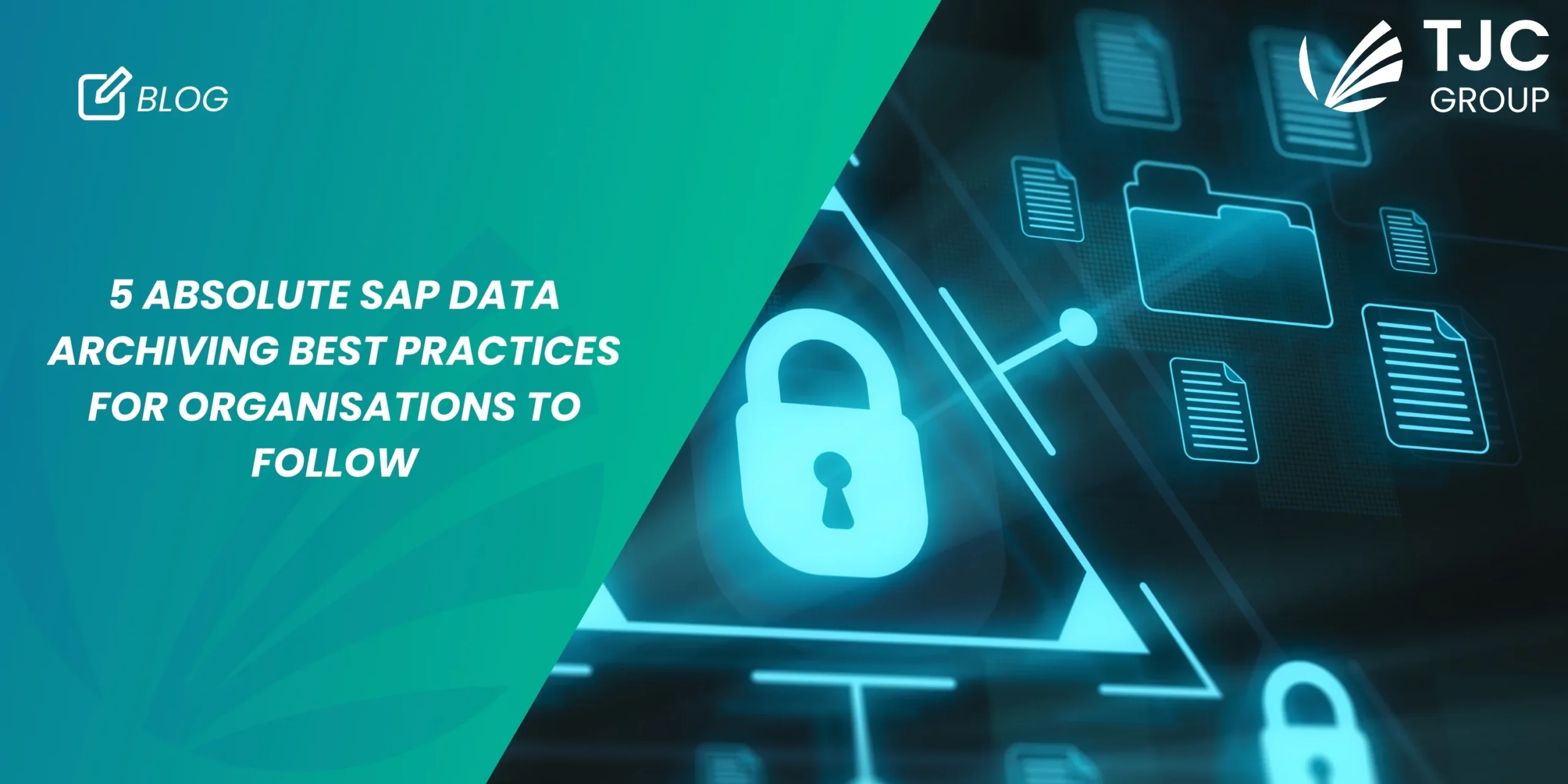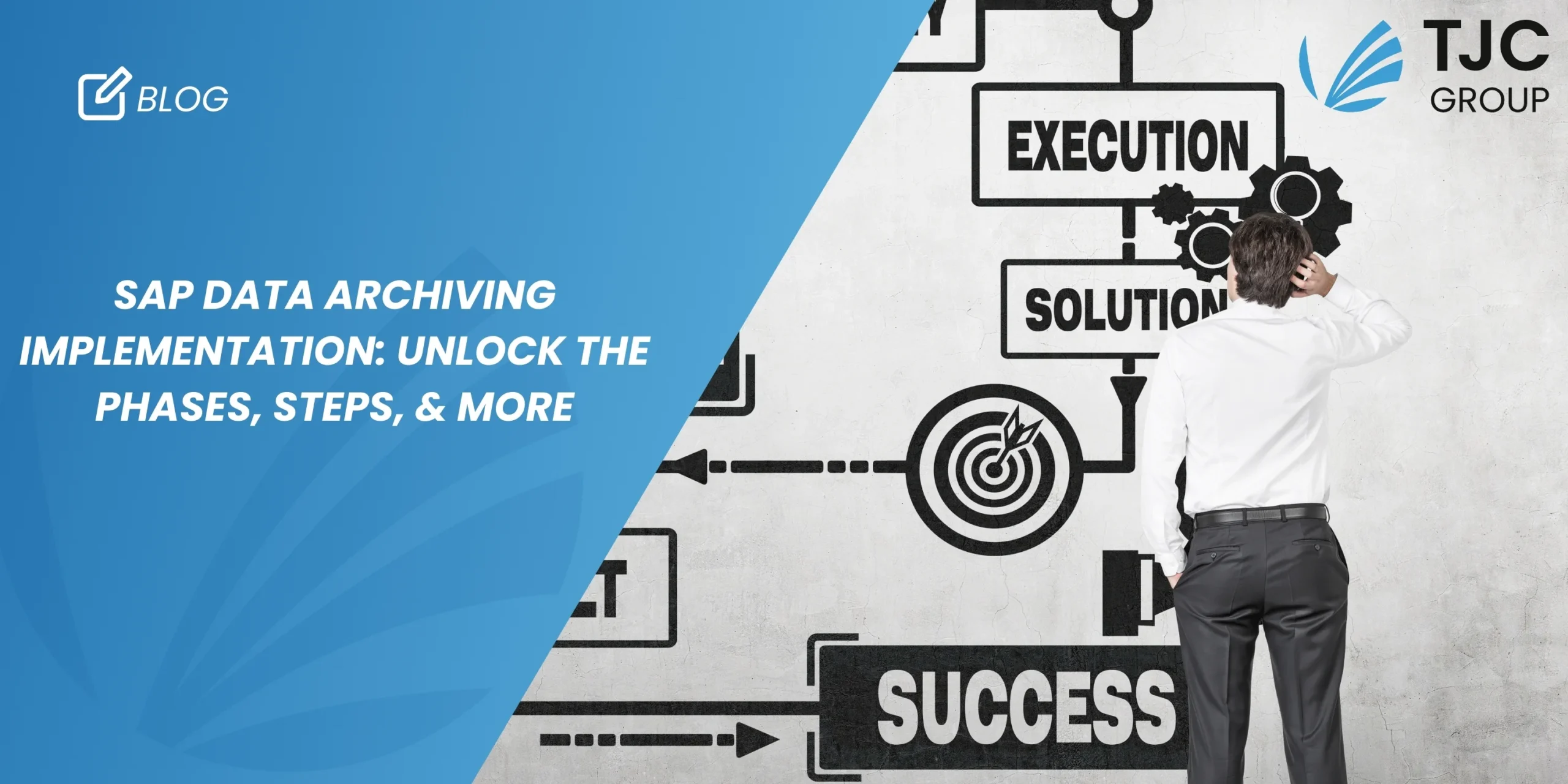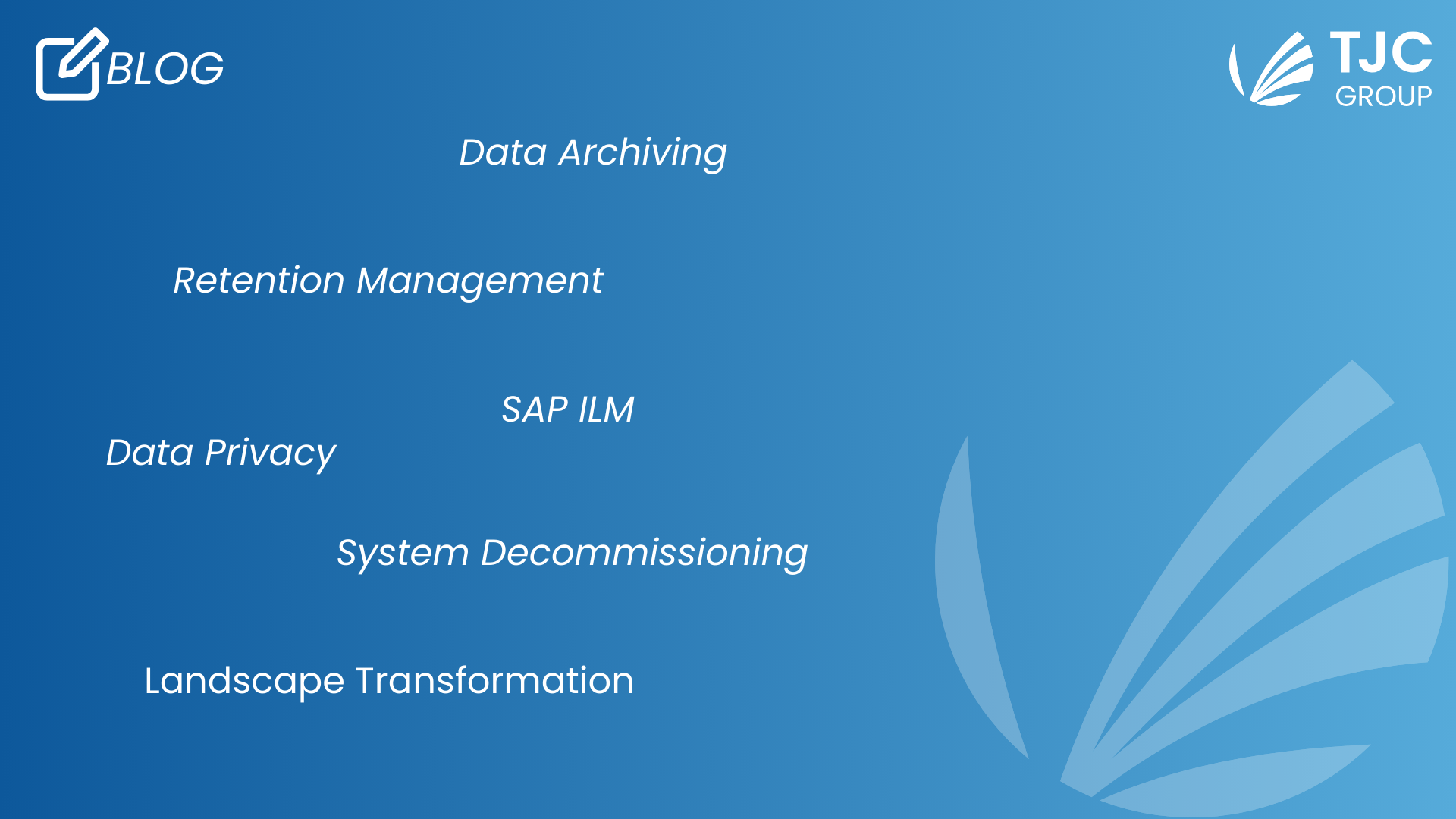
The world of SAP has a plethora of elements that one must know of. Right from SAP Data Archiving to SAP BTP, decommissioning, and more – the list is wide. Out of these, one of the most extensively used and known one is SAP Information Lifecycle Management (SAP ILM), which is comprised of 3 key elements: Data archiving, Retention Management and Retention Warehouse (or system decommissioning). In this blog, we will see in brief what Information Lifecycle Management is and what the ILM Store is all about. So, without any further ado, let’s dive in.
Table of contents
- What is SAP Information Lifecycle Management (ILM)?
- A little more about SAP data archiving
- SAP ILM Store | An overview
- Origin to determine the data source
- Prerequisites for using the ILM store
- Integration of the ILM Store into the archiving process
- How to use the ILM store?
- TJC Group – Your trusted SAP ILM partner
What is SAP Information Lifecycle Management (ILM)?
SAP Information Lifecycle Management, or SAP ILM is a comprehensive approach to automating data management. Here, from the creation and storage to decommissioning and deletion of data is done through rules to systematically determine how it was handled throughout its lifecycle. SAP ILM aims to optimise data flows, minimise legal compliance risks while reducing IT system costs.
That said, Information Lifecycle Management (ILM) in its core, operates towards the growing amounts of data, takes care of the more complex system landscapes while ensuring compliance for the ever-increasing legal regulations like the GDPR.
The General Data Protection Regulation or GDPR is one of the strictest privacy and security law, drafted and passed by the European Union (EU). With this, Europe strengthens its stance on data privacy, and though it GDPR was passed by the EU, it imposes obligations onto organisations anywhere, if they target or collect data related to people in the EU. The regulation is vast and ensuring compliance can be tedious. Hence, these require enhanced data governance and data protection methods, which is exactly where the SAP ILM comes in.
SAP ILM encompasses several key functionalities:
- Data Archiving: It allows you to move historical data from active database tables to storage media with reduced access time, freeing up space in the production database and enhancing system performance.
- Retention Management: This feature helps define and enforce data retention rules and policies, ensuring that data is kept for the required period and disposed of properly when it is no longer needed.
- Retention Warehouse: the third component involves different tools for decommissioning a legacy system so that archived data can be retrieved for reporting purposes or audits even though the original system has been shut down. Therefore, RW is a method for system decommissioning. When a legacy SAP system is no longer in use, SAP ILM can archive the data and shut down the system while still retaining access to the data if required.
A little more about SAP data archiving
Data archiving is a core element of SAP ILM focusing on data volume management. SAP data archiving is the process of moving data that is no longer required for day-to-day business from the SAP system to a separate storage location. Archiving is a process recommended by SAP to clean up the SAP standard tables; for enhancing system performance and seamless usability for shorter response time.
Importance of data archiving
- Data archiving is vital for businesses and organisations that acquire new information on a regular basis but must retain their existing data as well.
- Trends in government regulations, law, and corporate policies are in favour of more data, which is retained for longer periods but retrieved faster.
- Data archiving helps companies to stay updated with these trends, but at a much lower cost.
- Organizations set policies on the best way to archive data, which includes how to characterize the data that is to be archived.
- Data archiving requirements allow users to automate the identification and its procedure.
- These policies typically also touch upon security sensitivity, retention time frame, and other such parameters.
Now that you are well-versed with SAP ILM and its most important component, data archiving, let’s dig in to know everything about the SAP ILM Store, shall we?
SAP ILM Store | An overview
In simple words, the ILM Store enables users’ benefit by using SAP’s own store for the process of data retention, from archiving to the storing of the archived files. The SAP ILM Store is a component of Information Lifecycle Management, fulfilling the requirement specifications of BC-ILM 3.1 for its compliant storage systems. Using this store, users can store archived files while indexing them in a database using WebDAV interface standards.
Apart from this, you can also store the files using Retention Management for SAP ILM in a database, such as SAP IQ or SAP HANA, to stay within the SAP environment in S/4HANA. As a matter of fact, this helps optimise IT infrastructure while reducing the purchasing and maintenance costs of external WebDAV interfaces and storage media.
With SAP ILM Store, you can also control the entire data lifecycle, supporting the process within the SAP environment without any external interfaces. The figure below depicts how users can store data using retention management in ILM Store.

In conjunction with SAP ILM, users can opt for ILM Store as a more enhanced and secured alternative to the current third-party WebDAV stores. That said, users also have the option of connecting multiple application servers to the ILM Store as WebDAV servers. Adding to this, ILM Store is also a great asset when it comes to decommissioning the systems.
Origin to determine the data source
A central element for ILM Store configuration, origin supports the ILM store in determining its data source i.e., the data origin. It is important to note that all systems using the ILM Store identifies the data source in the context of an origin. The origin can be anything – an ILM object, an individual system, or any large group of systems. It consists of a data source for customising, along with the keys for all data combined in the origin.
Additionally, origin also supports handling data from various sources in a different manner. For example, data in the productive server group can be handled differently than the data from the ILM Retention Warehouse. However, to achieve this, it is mandatory to link each request to the ILM Store with the origin required.
There are two types of origin that users must know of, namely, administrative origin and operational origin. Origin for SAP ILM store is a vast topic, and we will be covering more about this in our future blogs.
Prerequisites for using the ILM store
With every new system, technology, and so on, comes requirements that users need to fulfil – and so does with ILM Store. There are a few pre-requisites that users need to fulfil for using the ILM Store. They are as described below –
1) The first requisite is to choose the database that you want to use. There are several databases that users can choose from, namely –
- Database for the enterprise edition of SAP IQ as of Version 15.4.
- SAP HANA database.
- Hadoop File System (HDFS)
- Azure Blog Storage

2) Secondly, once the database is chosen, users must switch on the ILM Store (ILM_STO) business function. To switch this on, choose the required release and then Application Help > Business Functions > Business Functions in SAP NetWeaver > ILM Database Store.
3) Thirdly, it is imperative to configure settings needed for the ILM Store and establish the database connection. For this, users must choose Media Library > Installation and Configuration Guide for ILM Store.
4) Lastly, users must use SAP ILM’s Retention Management. For this, choose the required release and then go to Application Help > Cross-Application Components > Cross-Application Functions > SAP Information Lifecycle Management.
Integration of the ILM Store into the archiving process
The integration of the ILM Store into SAP’s data retention process can help ensure that the process takes place within an SAP system landscape. The process of data archiving, data retention, and data storage using SAP ILM Retention Management is considered as a whole. Hence, the data retention process can be represented as an SAP integrated process, which can be managed without any third-party stores.
The following figure represents this process and its components schematically –

As per the figure, it is shown that the archiving client mirrors the user’s system with the data that needs to be archived and that the user operates with the Information Retention Manager (IRM). That said, to archive the data, users can use the ArchiveLink connection and SAP CMS. However, users need to have the Information Retention Manager’s SRS to control all processes that concerns the ILM Store. As a matter of fact, with the ILM Store, users can have a certified, SAP-specific store for BC-ILM 3.0.
Note: The BC-ILM 3.0 is an interface, which is an enhancement of the WebDAV protocol. It can be used to store and adjust data, and BC-ILM 3.0 is defined by ILM Retention Management. It is important for all store providers that use SAP ILM to implement the requirements of this interface; the SAP ILM Store implements the BC-ILM 3.0 interface, certified with a Certification Suite of AS ABAP.
How to use the ILM store?
Now that you have an idea about what an ILM Store is, let’s talk about how users can use this store.
The ILM Store can be used in different ways. If a multi-system hybrid landscape is considered, one system can be defined as a central store for one or more systems. That said, the archived files from a live S/4HANA system and a Retention Warehouse system can be connected to the same ILM Store, enabling a reduced total cost of ownership (TCO). This also leads to a simplified landscape, reduction in efforts for ILM Store setup, and so on. You can use the ILM Store in the following ways –
1) To store archived files with ILM Retention Manager
One of the simplest ways to use the ILM Store is to store archived files from S/4HANA application system to storage media, which is connected via the store. For this, users must execute the configuration while defining the origins in each application system.
2) As a centralised store server
As a centralised store server, the ILM Store can be configured in the following ways –
a) The local ILM Store configures the main ILM Store in the S/4HANA application system, following which it connects to one of the storage medias. In this case, the archiving client, the Storage and Retention Service (SRS) system, and the ILM Store are configured in the same S/4HANA system, while storing the archived files created within this system.

b) The remote ILM Store is a way in which users can define one of the systems as the Central ILM Store while enabling connection to several other applications. In this, the archived files created are stored in the storage media. The process for this quite simple – the request comes from the connected source application to the store and from the store, the file is stored in the storage media. Additionally, the remote ILM Store can also be used with ILM Retention Warehouse.

3) As a content server
The ILM Store can be configured to be used as a content repository, enabling the storage of ArchiveLink documents. In this scenario, the ILM Store operates as a content server for storing the data. However, please keep in mind that the ILM Store as a content repository comes with certain drawbacks. One of the major drawbacks is that the ILM Store can be used with Write Once Read Many (WORM) aspects. That said, appending and updating attachments are not supported either.
How to configure the SAP ILM store?
To configure the SAP ILM Store for the storage of archived files
- Enable SICF Service for the ILM Store: Users must create and activate a service for the ILM Store in SICF transaction.
- Configure connection: Next is to create DBCON or RFC for establishing a connection from ILM Store to storage media.
- ILM Store configurations: Here, users must create administrative origins and operational origins.
- Define routing parameters: Next, users must define the routing parameters to map the source data to the target location.
- Storage and Retention Services (SRS): Once the routing parameters are defined, users must configure and activate the Storage and Retention Services (SRS).
- Define ILM Store in administration: Lastly, users must define the ILM Store in the administration by creating an entry with all the details in ILMSTOREADM transaction.
To configure the ILM Store as a content repository
For configuring the ILM Store as a content repository to store archived files and documents from ArchiveLink, you must follow the given steps –
- Repeat the above steps from 1- 6 under “Set Up ILM Store to store archived files”.
- Configure and activate the ArchiveLink connection.
- Execute customising for FILE transaction.
TJC Group – Your trusted SAP ILM partner
The SAP ILM Store was previously known as the SAP ILM Database Store. But even then, it seems to an underrated star in the SAP world – mostly because not many are completely aware of its use. However, for the ILM Store, it is imperative that users are well-versed with the concept of SAP ILM. But if you are not, fret not! We’ve got you covered.
With an expertise of 25+ years, TJC Group is your trusted SAP ILM partner. We help you –
- Delete unnecessary data in your SAP system.
- Close processes that have been open for too long.
- Take advantage of GDPR regulation as an opportunity to review processes in depth.
- Remain compliant and protect your company’s reputation.
Apart from this, we also offer efficient SAP data archiving and data extraction solutions. To know more about our SAP ILM and data archiving solutions, contact us today!









